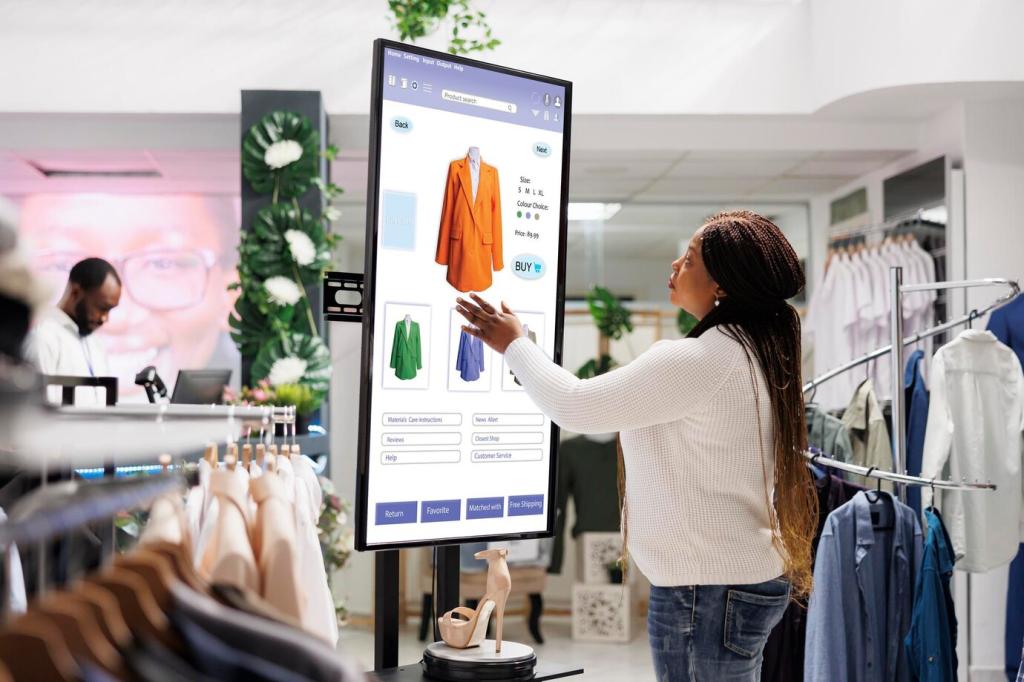Revolutionizing Online Retail with AI Solutions
Harnessing the transformative power of artificial intelligence, the world of online retail is undergoing a tremendous evolution. AI is more than a technological upgrade; it is fundamentally changing how retailers engage customers, manage operations, and drive growth. From personalized shopping experiences to frictionless logistics, AI empowers retailers to anticipate market trends, streamline their processes, and deliver exceptional value at every step of the buying journey. This new era of smart commerce is setting new benchmarks for customer satisfaction and business innovation, reshaping everything we know about shopping online.

Personalized Shopping Experiences
01
Dynamic Recommendation Engines
Dynamic recommendation engines harness advanced algorithms to analyze customer browsing histories, purchase patterns, and product preferences in real time. These sophisticated systems curate highly relevant product suggestions for each shopper, mimicking the personalized attention offered by in-store sales associates. By constantly learning and adapting to changing behaviors, these engines not only increase conversion rates but also improve average order values and customer satisfaction. The result is a seamless, intuitive shopping journey tailored to each customer’s unique tastes and interests.
02
AI-Powered Content Customization
AI-powered content customization goes beyond simple recommendations by redesigning entire storefronts in response to individual shopper profiles. From banners and imagery to product placements and offers, every element of the digital experience is optimized to resonate with the user’s preferences. This granular personalization fosters emotional connections, reduces bounce rates, and enhances brand loyalty. Retailers can leverage AI tools to test and refine content continuously, ensuring that customers see the messages and products most likely to inspire action.
03
Real-Time Behavioral Analysis
Real-time behavioral analysis enables retailers to respond instantly to shifting customer needs and browsing patterns. By monitoring clicks, scrolls, hovers, and abandonment signals, AI systems can trigger tailored offers, chat prompts, or content adjustments that keep shoppers engaged and guide them toward purchase. This proactive approach transforms passive browsing into dynamic, interactive sessions, helping online stores recover potentially lost sales and build stronger relationships with their audience.
Inventory Optimization Through AI
Predictive Stock Management
Predictive stock management uses machine learning models to forecast inventory needs based on historical sales, seasonality, market trends, and external factors such as promotions or events. By anticipating demand with remarkable precision, retailers can ensure optimal stock levels at all times, reducing the risk of excess inventory or missed sales opportunities. These predictive insights inform smarter purchasing and allocation decisions, helping brands stay agile in a constantly shifting marketplace.
Automated Replenishment Systems
Automated replenishment systems take the guesswork out of stock management by leveraging AI to track inventory levels continuously and trigger reordering processes when thresholds are approached. These systems account for a wide range of variables, from delivery lead times to vendor performance and shifting consumer preferences. As a result, retailers benefit from increased efficiency, fewer manual errors, and the ability to redirect human resources to more strategic initiatives, ultimately driving better customer experiences and streamlined operations.
Demand-Driven Pricing Strategies
Demand-driven pricing strategies powered by AI evaluate sales velocity, competitor pricing, market trends, and customer demand in real time to optimize price points dynamically. These systems enable retailers to respond quickly to market fluctuations, clear slow-moving inventory, and capitalize on peak demand periods. The result is a win-win scenario: improved margins for the retailer and fairer, more appealing prices for the customer. Through continual learning and adjustment, AI-driven pricing models become increasingly sophisticated and aligned with both business goals and customer expectations.
Enhanced Customer Support with AI Chatbots
01
Today’s AI chatbots offer instant, always-on support for customers across platforms and devices. Shoppers can get answers to common questions, navigate store policies, and resolve issues at any hour, without waiting for a human agent. This unwavering availability enhances user convenience, reduces response times, and can turn a potentially frustrating experience into a seamless and satisfying interaction. For global retailers, this level of support is vital in appealing to a diverse, around-the-clock customer base.
02
AI-driven chatbots are capable of conversing in multiple languages, breaking down barriers and making online retail accessible to customers worldwide. By understanding and responding fluently in the customer’s preferred language, these systems create a welcoming experience for shoppers from diverse backgrounds. Retailers can broaden their global footprint, reduce the risk of misunderstandings, and foster inclusivity by leveraging AI’s multilingual prowess.
03
Advanced chatbots do more than answer simple queries—they can interpret complex requests, track orders, process returns, and troubleshoot technical issues. By drawing on customer account information and historical interactions, AI agents offer context-aware support that feels genuinely personalized. When further assistance is needed, chatbots can seamlessly escalate cases to human agents, providing all relevant information for a smooth handover. This intelligent orchestration ensures speed, accuracy, and empathy throughout the customer support journey.

Smart warehouse automation uses AI-driven robotics, sensors, and control systems to streamline picking, packing, and shipping operations. Robots can navigate complex layouts, handle fragile items, and operate alongside human workers to achieve greater speed and accuracy. These automated systems reduce human errors, lower operational costs, and allow warehouses to scale rapidly in response to surges in demand. The outcome is faster delivery times and higher throughput, directly contributing to improved satisfaction for online customers.

AI-powered order tracking systems provide end-to-end visibility for both retailers and their customers. By aggregating data from carriers, warehouses, and logistics partners, these tools deliver up-to-the-minute status updates via web portals, mobile apps, and messaging platforms. Customers can check the location and estimated arrival of their packages without having to wait in uncertainty, while retailers gain insights that help them address potential delays proactively. This transparency builds trust and reduces the volume of “Where is my order?” inquiries.

AI algorithms excel at analyzing vast datasets to determine the most efficient delivery routes based on traffic patterns, weather, delivery windows, and customer locations. By continuously updating and optimizing routes, retailers and their logistics partners can cut down on fuel costs, emission footprints, and delivery times. This not only enhances operational efficiency but also supports sustainability goals, making the fulfillment process better for businesses, consumers, and the environment alike.
Fraud Detection and Security Enhancements
Real-Time Anomaly Detection
Real-time anomaly detection models monitor transactional and user behavior data as it happens, rapidly identifying suspicious activities that may indicate fraud, bot attacks, or policy violations. By flagging irregular patterns—such as unusual login locations, rapid-fire purchases, or unexpected payment methods—AI can prevent fraudulent transactions before they are completed. This proactive security approach reduces financial losses and preserves the integrity of online retail ecosystems.
Adaptive Authentication Processes
AI-powered authentication systems dynamically adjust security measures based on risk factors and contextual cues. Customers known to be low risk can benefit from frictionless logins, while those exhibiting anomalies may face additional verification steps. By intelligently calibrating security protocols, retailers maintain strong defenses without compromising on user experience. This balance reduces cart abandonment while bolstering protection against unauthorized access and account takeovers.
Predictive Threat Modeling
Predictive threat modeling leverages AI to anticipate new fraud tactics before they become widespread threats. By analyzing global patterns and emerging schemes, these systems enable online retailers to adapt their defenses in advance, reducing vulnerabilities to novel attacks. This forward-looking strategy protects both sensitive customer data and the retailer’s reputation, demonstrating a commitment to rigorous digital security in an ever-evolving landscape.

Image Recognition Capabilities
State-of-the-art AI models can analyze uploaded images and identify products, colors, patterns, and even subtle design features. Shoppers can snap a photo or screenshot an item they like to initiate a search, bypassing the challenge of finding the right keywords. This visual-first approach accelerates product discovery, reduces friction, and caters to users with diverse browsing habits and purchase inspirations.
Personalized Discovery Pathways
AI tailors each user’s journey through the store by blending their visual preferences with real-time contextual cues. Whether a customer is drawn to specific styles, fabrics, or brands, the platform can adjust product displays, suggest alternatives, or curate looks that resonate personally. This hands-on approach not only enhances the pleasure of shopping but also increases the likelihood of customers encountering products they truly love, translating into higher engagement and sales.
Augmented Reality Integration
The integration of AI and augmented reality (AR) allows shoppers to “try on” products virtually, from clothing to furniture. AI adapts virtual models to match users’ specific dimensions, skin tones, or room layouts, providing a realistic sense of how items will look and fit. This immersive experience reduces uncertainty, boosts confidence in purchasing decisions, and leads to lower return rates—all while deepening customer engagement with the brand.

Intelligent Customer Segmentation
Using clustering algorithms and deep learning techniques, AI systems segment customers by demographics, behaviors, values, and preferences with exceptional precision. Marketers can target these defined groups with individualized campaigns, offers, and content tailored to their unique desires. This data-driven segmentation increases campaign relevance and click-through rates, ultimately driving greater return on investment for every marketing dollar spent.

Predictive Campaign Analytics
Predictive analytics transforms raw data into foresight, enabling marketers to anticipate campaign performance, forecast trends, and optimize outreach timing. AI can simulate different creative messages, budget allocations, and user journeys to identify the combinations most likely to yield the best results. By iterating quickly and learning from real-world outcomes, retailers maximize the effectiveness of their marketing spend and adapt faster to changing consumer behavior.
